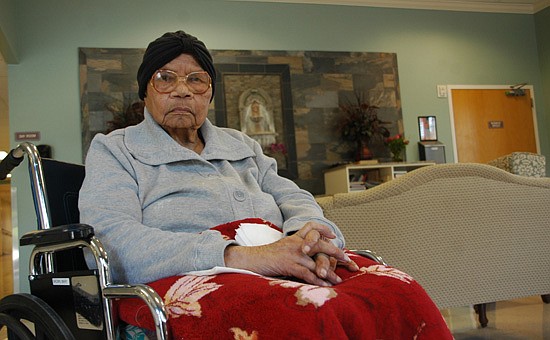- April 19, 2024
-
-
Loading

Loading

Latarsha Chisholm could still remember the sterile hallways of the James A. Haley Veterans’ Hospital. Blank, white walls and floors led to isolated rooms – quiet avenues where United States veterans spent the final years of their lives.
Residents ranging from ages 55 to 80 called these rooms home, while visits from family and friends dwindled with each passing year. Even the hospital staff seemed distant, only bringing food to bed-ridden residents.
Chisholm had come to the hospital as an intern from the University of South Florida in 2004, milling through admissions paperwork as part of her master’s degree in social work. She had no idea that she’d find her calling there.
When Chisholm wasn’t working in the mental health clinic or the spinal cord injury unit, she was in the nursing home wings. Something seemed wrong there, she said.
After seeing these former servicemen in isolation, Chisholm, now an assistant professor at the University of Central Florida, decided to dedicate her life to nursing home research, tracking down disparities found in their quiet hallways. Disparities that Chisholm now seeks to uncover.
An article written by Chisholm published in the June issue of Health Research Services indicates a nationwide trend in nursing homes: a drop in the quality of care in correlation with the number African American residents.
By compiling staff, financial and resident health data from more than 11,500 nursing homes, Chisholm found that more residents of color in nursing homes means a lower quality of care – a trend that Chisholm attributes to financial performance and the surrounding communities.
“What happens is unfortunately the nursing homes in minority communities are also affected by the resources in that community, which then effects the quality of care that they provide,” Chisholm said.
The recent study shows not only a drop in revenue in nursing homes with a large minority population, but a reduction in services offered to residents, including restorative walking and pressure ulcer prevention.
Chisholm reasoned that most minorities rely on Medicaid to pay for long-term care near the end of their lives, and that the reimbursement rates that go back to the nursing homes don’t fund enough of the treatment programs.
The fact that many minorities rely on Medicaid could possibly play a part in whether they’re admitted to certain nursing homes, Chisholm said.
“I don’t think it’s just them saying ‘we don’t want black residents,’ it’s probably more the fact that they don’t want Medicaid residents,” Chisholm said. “But unfortunately you can’t delink the two.”
One of the very first nursing homes specifically geared toward African Americans began in Winter Park. The Gardens at DePugh Nursing Center started in 1956, giving elderly African Americans a place to go during the civil rights movement.
Today the nursing home houses a variety of ethnicities, but the majority, 50 to 60 percent, remains African American.
Nursing home administrator Millie Sorger found the study interesting, but didn’t see the trend occurring at any point during her 30-year career, despite 80 percent of her residents at the DePugh Nursing Center relying on Medicaid.
“I haven’t had that experience personally, and I’ve had a number of buildings with very diverse communities,” said Sorger.
“This building has a lot more African Americans than my other buildings, and yet I personally see better care here than in most, and it’s probably because of how unique we are. We’re very supported by the Winter Park community.”
But Chisholm remains confident in her research. She proposed a number of different ways that the financial performance could be improved, including a pay-for-performance model to reward nursing homes for better care and introducing more of a blend in racial composition in nursing homes to even out Medicaid reimbursement.
But while boosting financial performance may help solve some the disparities, Chisholm said it wouldn’t solve everything.
“What we found is that the financial variables mediate a little bit of the ethnic disparities, but most of the time it did not,” Chisholm said. “What that indicates is that there are factors beyond the financial performance that are occurring in these nursing homes.”
“We need to see what’s going on in these nursing homes that may be facilitating the differences in care.”
Professor Robert Weech-Maldonado of the University of Alabama in Birmingham served as a mentor to Chisholm while she pursued her Ph.D. at the University of Florida, and gave her guidance while she wrote her recent article.
The trends that Chisholm found will only get worse with time, he said.
“Definitely the issue is not going away, especially as the number of minorities in nursing homes is actually increasing over time,” Weech-Maldonado said. “It’s an issue that will require increasing attention.”
The U.S. Census Bureau shows that the population of Americans older than age 65 will increase from 20 to 42 percent between 2010 and 2050. This combined with the American population becoming more diverse shows that the trend will continue, Chisholm said.
Chisholm hopes to shed further light on the trend by working on more articles. An article on what causes segregation in nursing homes is now in the revision stage, and she plans to write another article focusing on the quality of nursing homes housing primarily residents on Medicaid.
“The one thing we know is that we’re going to get old,” Chisholm said. “It’s just how we plan to spend that time.”
Chisholm expects to submit her article on nursing home segregation by the end of this year, with a potential publication coming early next year.